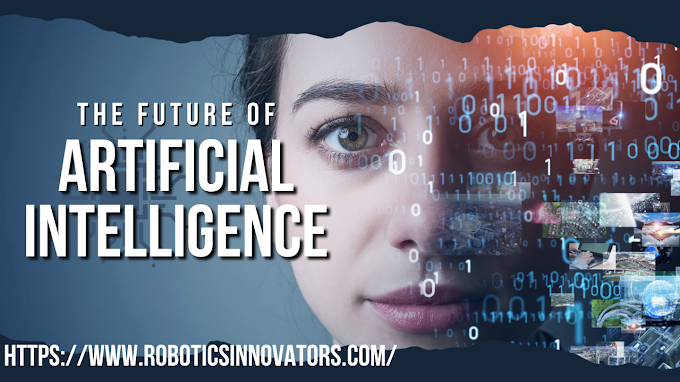A different field within artificial intelligence called robotics is used to research the development of intelligent robots and devices. Robotics, which contain mechanical construction and electrical components and are programmable using programming languages, integrate electrical engineering, mechanical engineering, and computer science and engineering. Although robotics and artificial intelligence (AI) have different goals and uses, most people still consider robotics to be an aspect of AI. Robotic devices have a striking resemblance to people in appearance, and if given access to artificial intelligence (AI), they are also capable of performing like humans.
Robotic applications were fairly restricted in the past, but by merging with artificial intelligence, they have now grown wiser and more effective. By displacing people in the industrial sector in terms of productivity and quality, AI has played a major role. In this post, we shall talk about robots and artificial intelligence, along with some of their many uses, benefits, and distinctions. The definitions of artificial intelligence (AI) and robots should come first.
How can artificial intelligence be defined?
The field of computer science and engineering known as artificial intelligence is focused on developing intelligent computers that behave like people. Machines can perceive, interpret, act, and learn in ways akin to humans thanks to artificial intelligence. Reactive machines, limited memory, theory of mind, and self-awareness are the four primary subtypes of AI.
Components of a Robot
Devices known as actuators are in charge of moving and controlling a machine or system. By converting energy like electrical, hydraulic, and air, etc., it aids in achieving physical motions. Both linear and rotational motion may be produced using actuators.
An electrical device known as a power supply provides power to an electrical load. The power supply's main job is to change electrical current so that it can power the load.
Electric motors: These are the machines needed to propel machines into rotation by converting electrical energy into mechanical energy.
Pneumatic Air Muscles: Soft pneumatic devices called air muscles are best suited for robotics. They work by pressing air into a pneumatic bladder, which allows them to compress and extend.
Muscle wire: These are composed of an extremely thin nickel-titanium alloy known as Nitinol. When a certain amount of heat and electric current are injected into it, it may also expand and shrink. When it is in its martensitic condition, it may also be shaped and bent into various forms. When an electrical current flows through them, they have a 5% capacity to contract.
Ultrasonic and piezoelectric motors Electrical devices known as piezoelectric motors or piezo motors use a directed force to push against an opposing ceramic plate after receiving an electric signal. A robot can travel in the desired direction with its assistance. These electrical motors are ideal for industrial robotics.
Sensor: They offer human-like abilities like sight, hearing, touch, and mobility. Sensors are tools or machines that assist in spotting occurrences or alterations in the environment and provide information to the computer processor. Usually, these gadgets come with other technological gadgets. Electrical sensors are essential in robotics and artificial intelligence, much like human organs are. Robots are controlled by AI algorithms that sense their surroundings and feed real-time data to computer processors.
The Uses of Robotics
Different fields of application exist for robotics. The following list includes some significant robotics application areas:
Robotics in the military: The military is unquestionably one of the most important sectors of any nation. Every nation desires a robust defense system. Robots assist in approaching risky and inaccessible areas during combat. To safely demolish things that pose a hazard to human life, DRDO created the robot Daksh. The military uses them in battle situations to aid soldiers in staying safe. Robots are also used in anti-submarine operations, fire support, battle damage management, strike missions, and laying machines, in addition to combat support.
Robotics in the medical sector: Robots are also useful in a number of medical specialties, including laparoscopy, neurosurgery, orthopedic surgery, room disinfection, drug administration, and other medical and
Robotics in the Industrial Sector: Robots are used in a number of manufacturing processes in the industrial sector, including cutting, welding, assembly, disassembly, pick-and-place for printed circuit boards, packaging and labeling, palletizing, product inspection and testing, color coating, drilling, polishing, and handling of and
Robotics technology also lessens human effort due to less physical strain and damage while increasing productivity and profitability. The industrial robot offers the following significant benefits:
decreased labor costs
noise-free functioning
fewer production-related defects
increased rate of production.
Robotics in Entertainment: Over the past ten years, the usage of robots in the entertainment industry has steadily risen. Robots are used in the entertainment industry, including film, animation, video games, and cartoons. Where repetitive operations are necessary, robots are particularly useful. A robot holding a camera assists in filming a scenario as many times as necessary without growing weary or annoyed. Hundreds of robots have been introduced by a well-known Disney for the film business.
Robots in the mining industry: Robotics is highly useful for a variety of mining applications, including robotic dozing, excavation and haulage, robotic mapping and surveying, robotic drilling, robotic handling of explosives, etc. A mining robot can only go through flooded tunnels while searching for precious minerals using cameras and other sensors. Robots can also assist in excavation by detecting gases and other contaminants, protecting people from danger and injury. Ocean exploration uses underwater drones, while space exploration uses robot rock climbers.
Robotics employs artificial intelligence.
Machine Learning
Robots can see, too, thanks to computer vision, one of the most well-known applications of artificial intelligence. Every industry, including health, entertainment, medical, military, mining, etc., greatly benefits from computer vision.
Computer vision is a crucial area of artificial intelligence that aids in gleaning critical data from pictures, films, and other visual inputs and taking appropriate action.
Automatic language recognition
To speak to AI robots, NLP (natural language processing) can be employed. Strong human-robot interaction is produced by it. NLP is a particular branch of artificial intelligence that makes it possible for people and machines to communicate. The robot can comprehend and imitate human discourse using the NLP approach. Some robots have NLP capabilities, making it impossible for us to tell some from others.
Similar to this, in the healthcare industry, NLP-powered robots may assist doctors in observing the specifics of the disease and automatically filling up the EHR. In addition to understanding human language, it can forecast how people will speak and pick up on common usages like accents.
Using the Edge
Robot edge computing is a service that offers robot integration, testing, design, and simulation. Robotics edge computing offers better data management, cheaper connectivity, better security procedures, and more dependable, uninterrupted connections.
The Process of Complex Events
A notion called complex event processing (CEP) clarifies how many events are processed simultaneously. An event is defined as a change of state, while a complex event is defined as the combination of one or more events. The phrase "complex event process" is most frequently used in a variety of fields, including marketing, finance, security, and healthcare. It is largely employed in the sphere of stock marketing as well as the detection of credit card fraud.
For instance, real-time data from several sensors is used to create the complicated event of the deployment of an airbag in an automobile. Robotics uses this concept, for instance, when programming autonomous robots to handle events.
AI and transfer learning
This method involves using a previously solved problem to assist in the solution of the current one. The information obtained from addressing one problem can be applied to other problems that are related to the transfer learning approach. The model used to identify a circular form may also be used to identify a square shape, for instance, which helps us better comprehend the concept.
Transfer learning just trains the last layer of the model, which takes considerably less time and is less expensive, and reuses the previously learned model on a comparable issue. Transfer learning may be used in robotics to train a machine with the assistance of other machines.
Reward-Based Learning
A machine learning technique called reinforcement learning allows an artificial intelligence agent to learn about its surroundings, take actions, and automatically learn from the results of those activities. Additionally, it has the ability to learn on its own through hit-and-trail behavior how to behave best when interacting with its surroundings. It is generally used to create a decision-making process and reach objectives in complex and possibly unpredictable environments. Robots in robotics investigate the
Transfer learning just trains the last layer of the model, which takes considerably less time and is less expensive, and reuses the previously learned model on a comparable issue. Transfer learning may be used in robotics to train a machine with the assistance of other machines.
Reward-Based Learning
A machine learning technique called reinforcement learning allows an artificial intelligence agent to learn about its surroundings, take actions, and automatically learn from the results of those activities. Additionally, it has the ability to learn on its own through hit-and-trail behavior how to behave best when interacting with the surroundings. It is generally used to create a decision-making process and reach objectives in complex and possibly unpredictable environments. Robots in robotics investigate theWhat are robots that have artificial intelligence?
Robots that are artificially intelligent combine robotics with AI. Machine learning, computer vision, reinforcement learning, and other AI technologies are used by AI programs to govern AI robots. The majority of robots are often not AI robots; instead, they are designed to carry out a sequence of repeated actions and do not require AI to do so. However, the capabilities of these robots are constrained.When you wish to enable the robot to carry out increasingly sophisticated jobs, AI algorithms are required.
A path-finding algorithm may be used by a warehouse robot to move around the space. When its batteries are ready to run out, a drone may employ autonomous navigation to find its way back home. AI algorithms may be combined in a self-driving automobile to What benefits may robots expect from incorporating artificial intelligence?
Social care is one of the main benefits of artificially intelligent robots. With chatbot-like social skills and cutting-edge processing, they can assist humans, especially elderly ones who need assistance.
Robotics also supports the agricultural sector by creating AI-based robots. The farmer's workload is lessened by these robots.
Military robots can save lives by replacing troops and spying using speech and vision detectors, among other things.
Robotics is also used in environments where people can't ordinarily exist, such as volcanoes, deep oceans, extremely cold climates, or even space.
Robotics are also employed in the medical and healthcare sectors since they can carry out complicated operations where human error is more likely to occur.
Differences between AI programs and robot systems
Here are the distinctions between robots and artificial intelligence:
1. AI software
Typically, we operate them in virtual environments created by computers.Input is often provided in the form of symbols and rules.
We require general-purpose or special-purpose machines to run this.
Two. Robots
Typically, we employ robots to carry out tasks in the actual, physical world.It is possible to provide inputs in the form of a voice waveform or an analog signal.
Additionally, specialized gear with sensors and effectors is required to run this.








.jpg)




